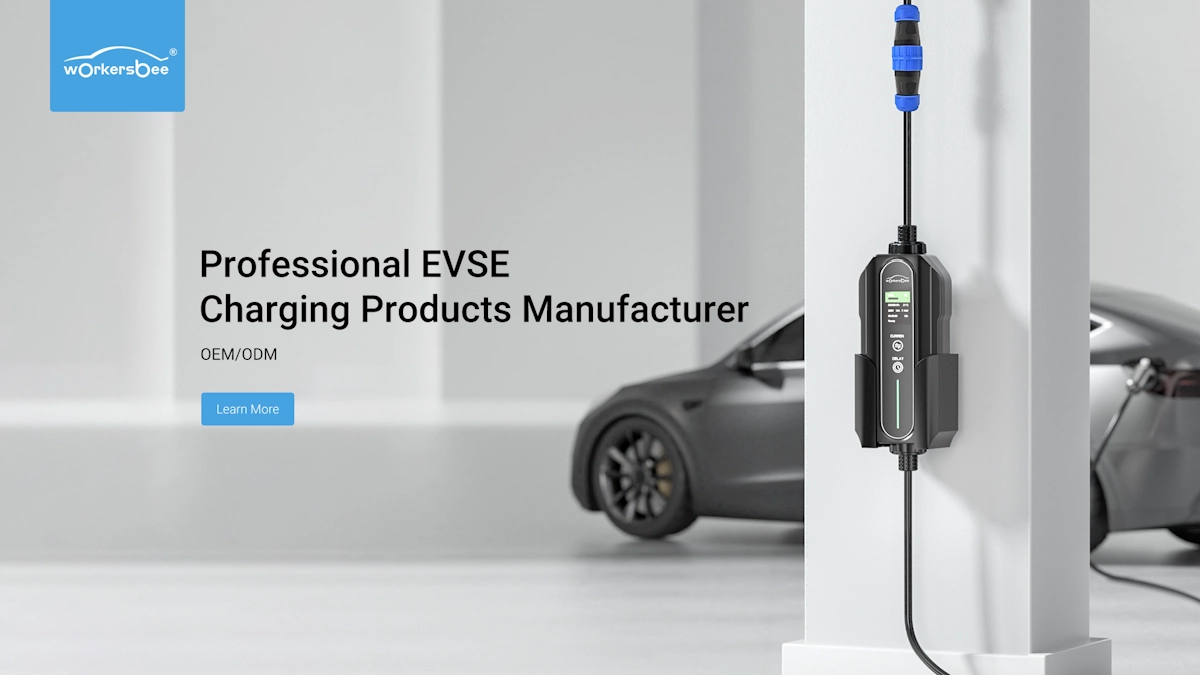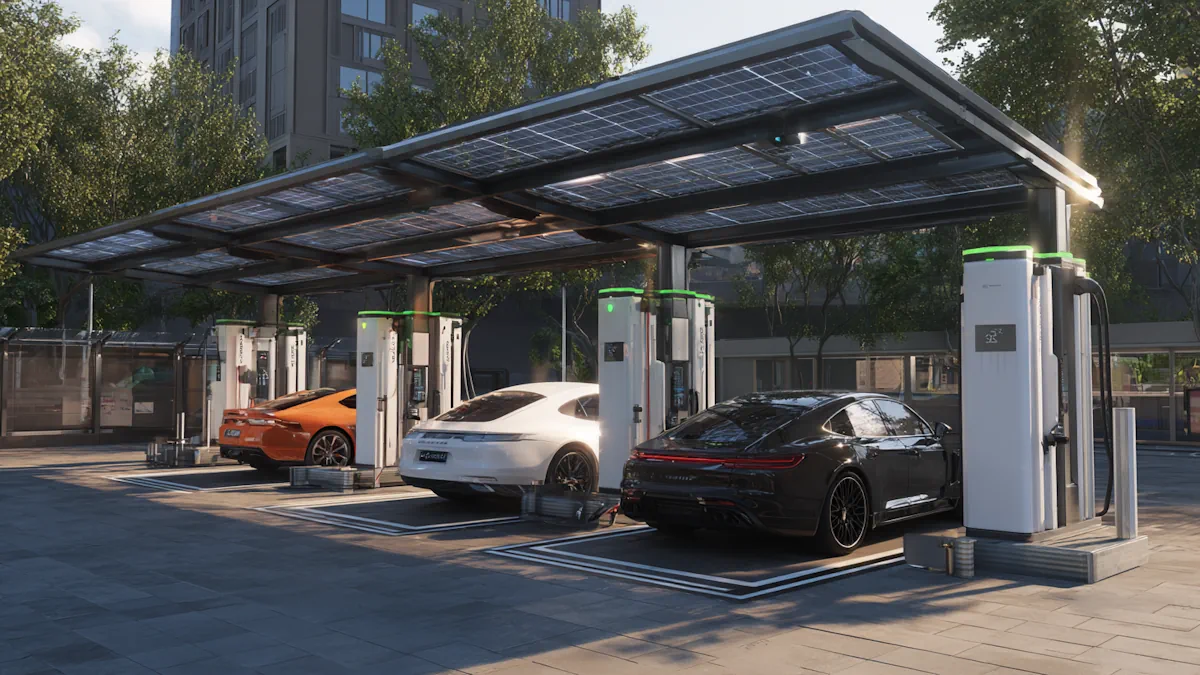 ¿Son todos los cargadores de nivel 2 para vehículos eléctricos iguales?
¿Son todos los cargadores de nivel 2 para vehículos eléctricos iguales?
Nov 05, 2025
No son iguales. La velocidad real de carga está limitada por el menor de tres factores: la capacidad de la instalación eléctrica de tu casa multiplicada por la potencia nominal del cargador y por la capacidad del cargador integrado de tu vehículo (OBC). Además, las unidades difieren en el estilo de instalación, las funciones inteligentes, la protección contra la intemperie y el tipo de enchufe. La potencia de carga no es igualLos amperios se convierten a kilovatios (kW) multiplicando voltios × amperios ÷ 1000. En una alimentación típica de 240 V, 32 A equivalen aproximadamente a 7,7 kW, 40 A a unos 9,6 kW y 48 A a unos 11,5 kW. Algunos modelos con cableado fijo admiten hasta 80 A (≈19,2 kW), pero esto solo es útil si el panel eléctrico, el circuito derivado, el cableado y el vehículo lo soportan.La mayoría de las viviendas utilizan circuitos de entre 40 y 60 A para una instalación dedicada de Nivel 2. Dado que la carga de vehículos eléctricos es una carga continua, se recomienda no utilizar más del 80 % de la capacidad del interruptor automático para una carga sostenida. Por lo tanto, un interruptor de 50 A soporta aproximadamente 40 A de carga continua; uno de 60 A, aproximadamente 48 A. ¿Cuándo tiene sentido usar 19,2 kW? Si dispone de la capacidad de servicio, un cableado corto, un vehículo con un ordenador de a bordo de alta potencia y necesita que los vehículos estén listos rápidamente. Si el ordenador de a bordo de su vehículo alcanza un máximo de 7,2 a 11 kW (como suele ser el caso), superar los 48 A no afectará a la velocidad de carga real. AMPa → kW → circuito → caso de uso típicoClasificación del cargador (A)Aprox. kW a 240 VInterruptor típico (A)Caso de uso común32~7.740Carga doméstica diaria, la mayoría de los PHEV/BEV40~9.650Carga doméstica más rápida en paneles de tamaño mediano48~11.560El extremo superior para muchas viviendas, los vehículos con limitaciones de OBC se benefician80 (cableado)~19.2100 (dedicado)Viviendas de gran capacidad, flotas comerciales/privadas, vehículos de alto consumo. Tipos de enchufes y compatibilidadSi tu coche utiliza el conector J1772 para el aire acondicionado, cualquier unidad J1772 de nivel 2 encajará perfectamente. Si la entrada de aire de tu coche es NACS/J3400, tendrás que usar una unidad NACS original o un adaptador compatible, dependiendo de lo que viniera con el vehículo y de la disponibilidad local. Las unidades con cable fijo son prácticas y ordenadas; los diseños con enchufe aceptan cables intercambiables y pueden simplificar el reemplazo.La longitud del cable es importante: si es demasiado corto, resulta incómodo; si es demasiado largo, pesa más y se desgasta con mayor facilidad. Un buen sistema de sujeción y una correcta colocación del soporte prolongan la vida útil del cable. Para garajes frente a entradas de vehículos al aire libre, tenga en cuenta el recorrido del cable, los bucles de goteo y la ubicación del mango para protegerlo de la lluvia y el sol. Inteligente vs. BásicoLas funciones inteligentes automatizan las tareas tediosas. La programación te permite cargar en horas valle y terminar antes de salir. El contador muestra los kWh y el coste. El reparto de energía (equilibrio de carga) permite conectar dos o más puertos a un mismo circuito sin que salten los interruptores. Las actualizaciones de firmware corrigen errores y añaden nuevas funciones con el tiempo.Algunos ecosistemas más recientes anuncian compatibilidad bidireccional (vehículo-hogar o vehículo-red eléctrica). Su uso depende de su vehículo, la instalación eléctrica de su hogar y la normativa local.Un sistema básico sigue siendo una buena opción si tienes una tarifa fija, un solo coche y prefieres una configuración sencilla y sin complicaciones. Un sistema inteligente resulta valioso cuando gestionas tarifas por franjas horarias, compartes un circuito o necesitas datos y control remoto. Instalación y conceptos básicos de seguridadLas instalaciones cableadas son más limpias y admiten corrientes más altas; las unidades enchufables (NEMA 14-50 o 6-50) son flexibles y más fáciles de reemplazar. Siga las reglas de reducción de potencia para cargas continuas y respete los límites de corriente del enchufe; no combine una unidad con una de mayor capacidad. Cargador de 48 A con un receptáculo 14-50 y espere 48 A continuos.Antes de instalar el conducto, verifique la capacidad del panel, los espacios disponibles para interruptores, el calibre del servicio y la ruta desde el panel hasta el punto de montaje. Los tramos largos y las curvas pronunciadas del conducto aumentan el costo y reducen el espacio libre.Para exteriores, busque cajas con la clasificación adecuada (por ejemplo, NEMA 3R, 4 o 4X; o IP66/67) y marcas de certificación como UL o ETL. Se requiere protección GFCI; los modernos EVSE la gestionan internamente, pero su electricista se asegurará de que todo el sistema cumpla con la normativa.La gestión de cables es en parte seguridad y en parte durabilidad: los soportes y fundas mantienen el asa alejada del suelo, evitan riesgos de tropiezos y reducen la tensión en el cable. Cuánto tiempo tardaráEl nivel 2 abarca aproximadamente de 7 a 19 kW. Una batería BEV de tamaño mediano puede pasar de un nivel de carga bajo al 80 % en unas cuatro a diez horas, dependiendo de la potencia efectiva. Los PHEV, con baterías más pequeñas, suelen cargarse por completo en una o dos horas. Dos ejemplos rápidos:• OBC-limitada: Tu coche admite un máximo de 7,2 kW. Incluso con una unidad de 48 A en un circuito de 60 A, seguirás viendo unos 7,2 kW.•Circuito limitado:Tu coche puede soportar 11 kW, pero has instalado una unidad de 32 A en un circuito de 40 A; obtendrás unos 7,7 kW. MicromesaTamaño de la batería (kWh)kW efectivosAproximadamente horas hasta el 80%507.7~5.2607.7~6.3759.6~6.38211.5~5.710011.5~7.0(Las estimaciones asumen una carga casi lineal en CA; los tiempos reales varían con la temperatura, el estado de carga inicial y la configuración del vehículo). Gráfico de decisiónPiensa en línea recta:Circuito doméstico (disyuntor y cableado en amperios) → Potencia del EVSE (amperios) → Ordenador de a bordo del vehículo (kW). Convierta los amperios a kW a 240 V cuando sea necesario. El menor de estos tres valores se convierte en su potencia de carga efectiva. A partir de ahí, divida la capacidad útil de la batería (kWh) entre la potencia efectiva (kW) para estimar las horas de carga.Notas adicionales: se aplica la regla del 80% de carga continua; las longitudes de cable muy largas y las altas temperaturas ambiente pueden reducir ligeramente los resultados. Preguntas frecuentes¿Los cargadores de mayor amperaje siempre son más rápidos?No automáticamente. La velocidad de carga está limitada por el menor de tres factores: la capacidad del circuito eléctrico, la potencia del cargador y la del cargador integrado del vehículo (OBC). Si el OBC tiene una potencia de 7,2 kW, un cargador de 48 A en un circuito de 60 A no superará los 7,2 kW aproximadamente. Un mayor amperaje solo es útil si los tres componentes lo soportan. Piense en los amperios como un margen de seguridad: solo se beneficia si el resto del sistema puede utilizarlo. ¿Necesito cableado directo para 48 A o más?En la práctica, sí. Las instalaciones con enchufes (p. ej., NEMA 14-50/6-50) se suelen usar a 40 A continuos debido a la regla del 80 % para cargas continuas y los límites de los receptáculos. Para suministrar 48 A continuos, la mayoría de las jurisdicciones y fabricantes recomiendan una instalación cableada en un circuito de 60 A con conductores del tamaño adecuado. El cableado también reduce el calor en la conexión y evita el desgaste de los receptáculos con el tiempo. ¿Puedo instalarlo al aire libre durante todo el año?Sí, si la unidad y la instalación cumplen con los requisitos. Busque gabinetes con clasificación NEMA 3R/4/4X o IP66/67, un cable resistente a los rayos UV y una funda que mantenga el asa elevada. Añada un bucle de goteo, mantenga las conexiones dentro de una caja resistente a la intemperie y evite el contacto directo con aspersores o agua estancada. En climas con nieve o salinidad, los componentes de acero inoxidable y un gabinete 4X ofrecen mayor resistencia a la corrosión. ¿Merece la pena tener 19,2 kW (80 A) en casa?Solo si se cumplen tres requisitos: que el servicio eléctrico y el cableado admitan un circuito dedicado de alta intensidad, que el vehículo acepte más de 11 kW de corriente alterna y que se obtenga un beneficio real gracias a tiempos de espera más cortos. Muchos coches limitan la corriente alterna a entre 7 y 11 kW, por lo que no se apreciaría ninguna mejora en la velocidad. Las instalaciones de alta intensidad también son más caras (actualizaciones del panel eléctrico, cables más gruesos, conductos más largos). Si se utilizan varios vehículos eléctricos por la noche o se dispone de una batería de gran capacidad y horarios ajustados, puede resultar rentable. ¿Reemplazará NACS la compatibilidad con J1772 en mi coche actual?No de una forma que te deje sin opciones. La carga de CA sigue siendo interoperable mediante adaptadores e infraestructura de estándares mixtos durante la transición. Si tienes un vehículo con entrada J1772, un cargador de pared J1772 sigue siendo una opción segura; si más adelante cambias a un vehículo con entrada NACS, puedes usar un adaptador o reemplazar el cable en algunas unidades. Prioriza la certificación y la clasificación de la carcasa sobre la búsqueda del logotipo del enchufe más reciente. ¿Qué cambiará en 2025-2026?Están surgiendo unidades de CA de mayor corriente junto con mejores sistemas de compartición de energía para hogares con varios vehículos y pequeñas flotas. Algunos ecosistemas están probando funciones bidireccionales, pero su uso generalizado y sin complicaciones aún depende de la compatibilidad entre vehículos y equipos domésticos. La infraestructura de enchufes está convergiendo, pero la carga doméstica diaria sigue siendo la misma: elegir la corriente adecuada, instalarla correctamente y dejar que el ordenador de a bordo (OBC) establezca el límite máximo. Elija un cargador teniendo en cuenta tres aspectos: el circuito que puede soportar de forma segura, la potencia nominal del cargador y el ordenador de a bordo de su vehículo. Después, decida qué nivel de conectividad desea y asegúrese de que la caja de carga y el cableado se ajusten al lugar donde aparcará. De esta forma, evitará comprar un cargador de más, instalar uno de menos y decepcionarse con la velocidad de carga en la práctica.
LEER MÁS

 Cómo funcionan realmente las estaciones de carga de vehículos eléctricos
Cómo funcionan realmente las estaciones de carga de vehículos eléctricos
 ¿Son todos los cargadores de nivel 2 para vehículos eléctricos iguales?
¿Son todos los cargadores de nivel 2 para vehículos eléctricos iguales?